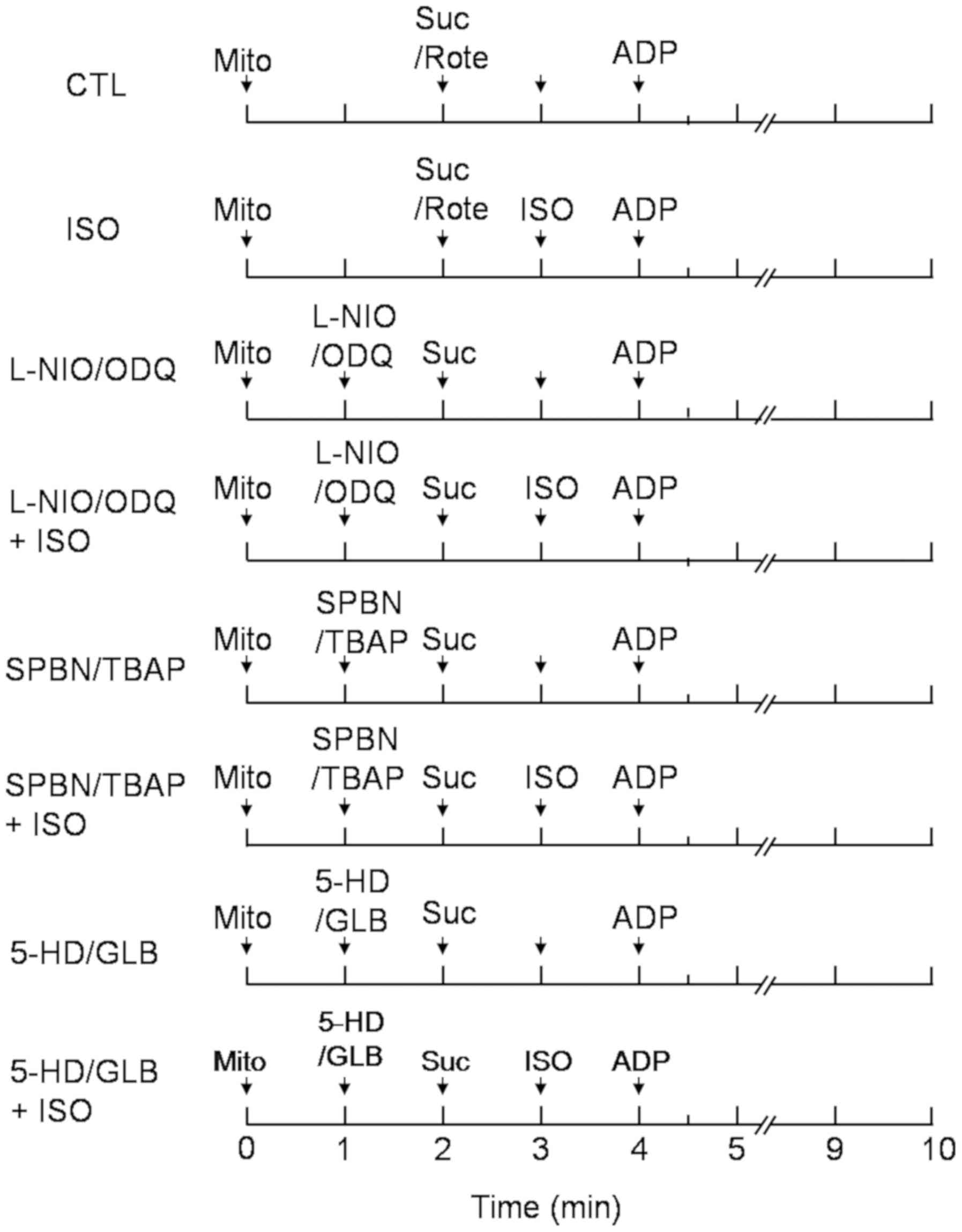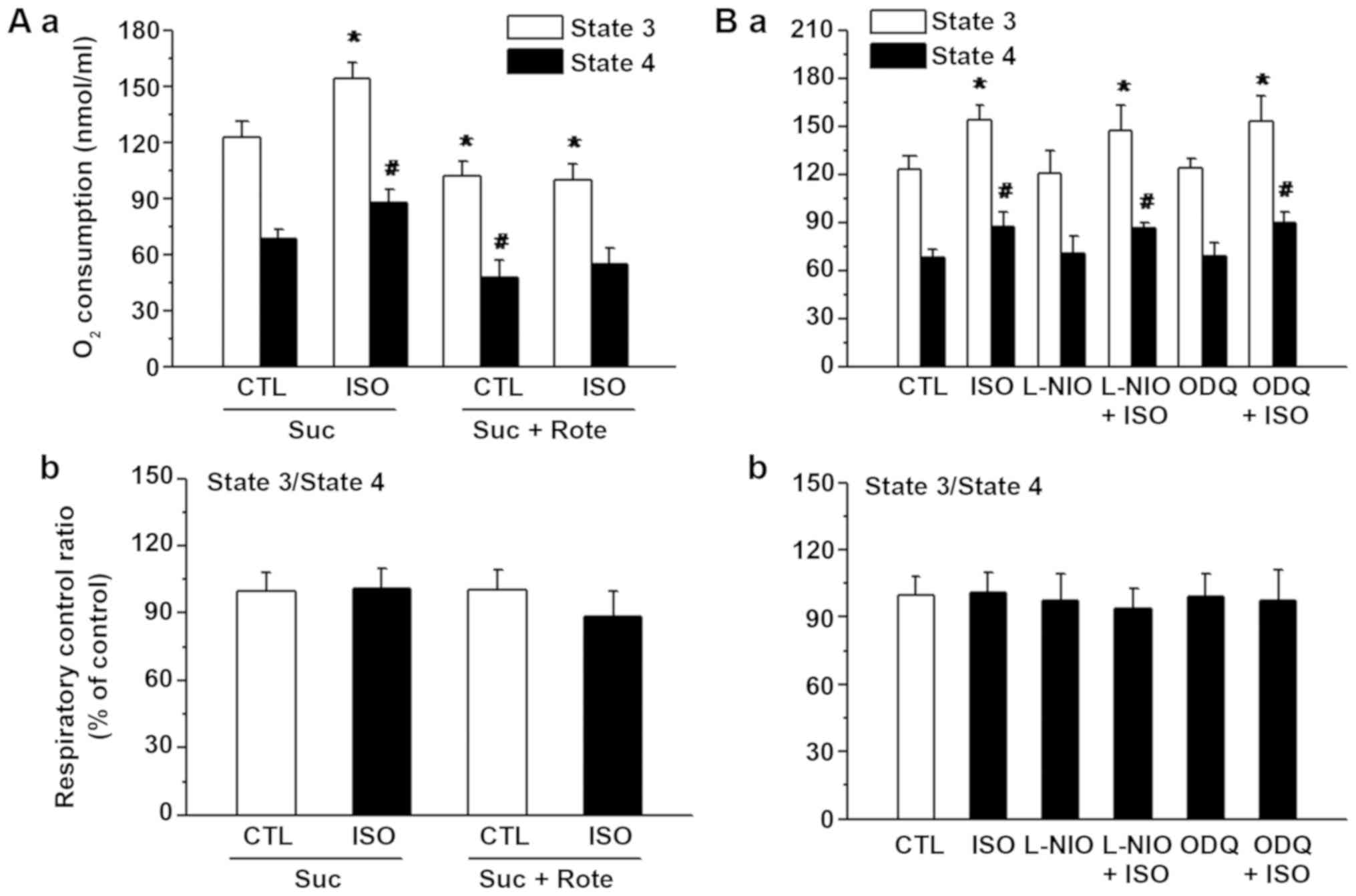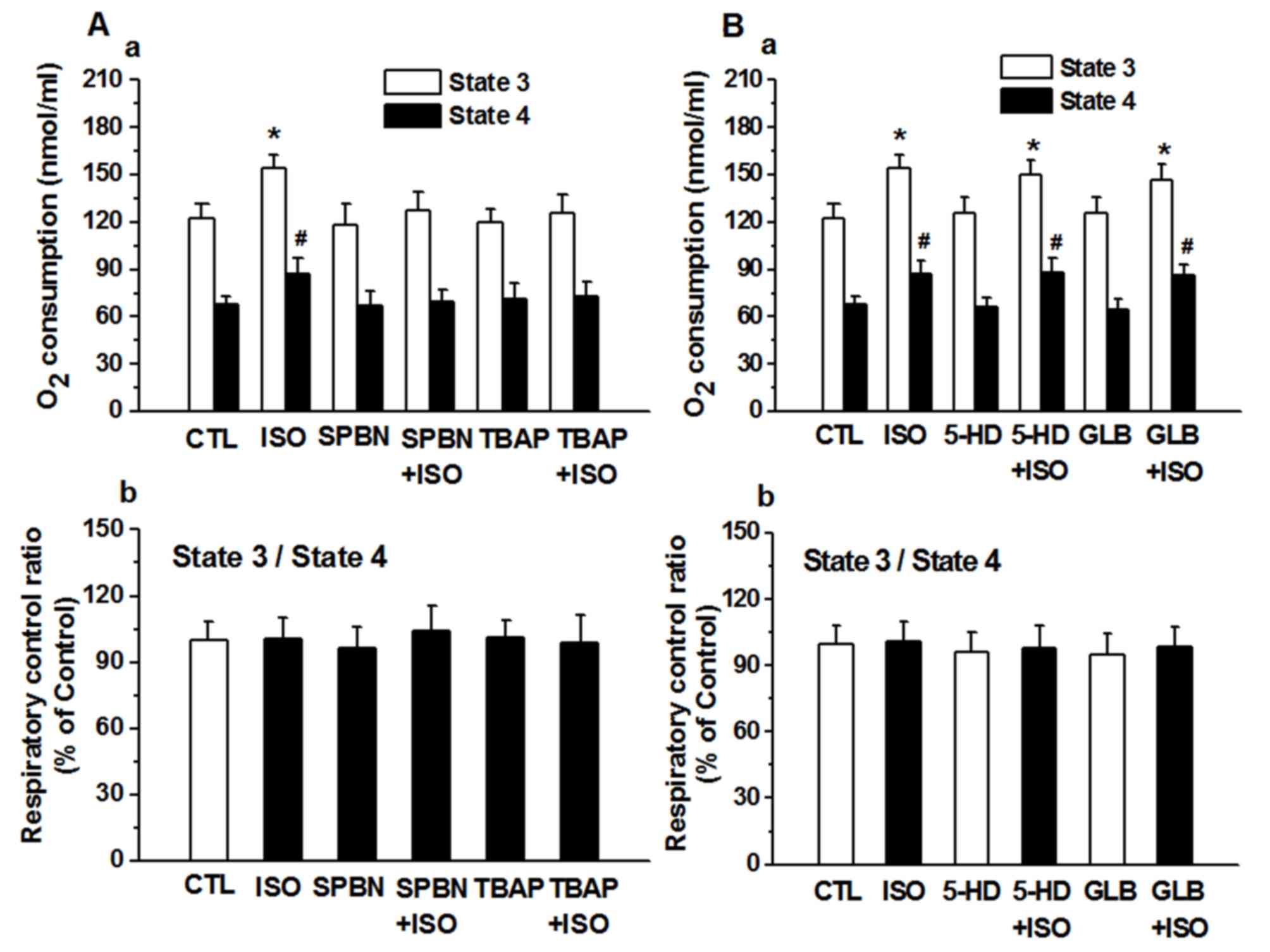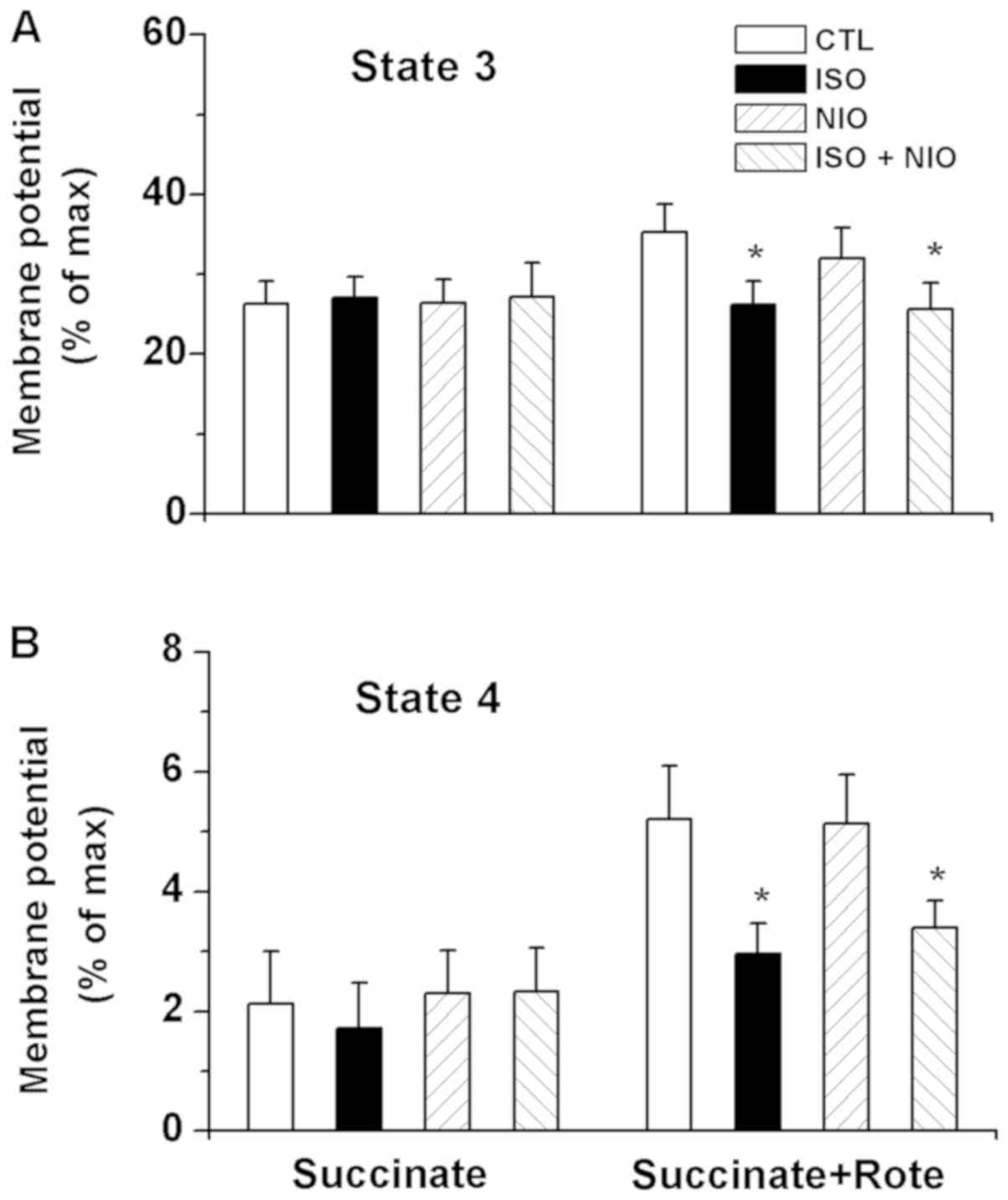|
1
|
Swyers T, Redford D and Larson DF:
Volatile anesthetic-induced preconditioning. Perfusion. 29:10–15.
2014. View Article : Google Scholar : PubMed/NCBI
|
|
2
|
Ge ZD, Pravdic D, Bienengraeber M, Pratt
PF Jr, Auchampach JA, Gross GJ, Kersten JR and Warltier DC:
Isoflurane postconditioning protects against reperfusion injury by
preventing mitochondrial permeability transition by an endothelial
nitric oxide synthase-dependent mechanism. Anesthesiology.
112:73–85. 2010. View Article : Google Scholar : PubMed/NCBI
|
|
3
|
Cao J, Xie H, Sun Y, Zhu J, Ying M, Qiao
S, Shao Q, Wu H and Wang C: Sevoflurane post-conditioning reduces
rat myocardial ischemia reperfusion injury through an increase in
NOS and a decrease in phopshorylated NHE1 levels. Int J Mol Med.
36:1529–1537. 2015. View Article : Google Scholar : PubMed/NCBI
|
|
4
|
Camara AK, Bienengraeber M and Stowe DF:
Mitochondrial approaches to protect against cardiac ischemia and
reperfusion injury. Front Physiol. 2:132011. View Article : Google Scholar : PubMed/NCBI
|
|
5
|
Li H and Lang XE: Protein kinase C
signaling pathway involvement in cardioprotection during isoflurane
pretreatment. Mol Med Rep. 11:2683–2688. 2015. View Article : Google Scholar : PubMed/NCBI
|
|
6
|
Bolli R: Cardioprotective function of
inducible nitric oxide synthase and role of nitric oxide in
myocardial ischemia and preconditioning: An overview of a decade of
research. J Mol Cell Cardiol. 33:1897–1918. 2001. View Article : Google Scholar : PubMed/NCBI
|
|
7
|
Chiari PC, Bienengraeber MW, Weihrauch D,
Krolikowski JG, Kersten JR, Warltier DC and Pagel PS: Role of
endothelial nitric oxide synthase as a trigger and mediator of
isoflurane-induced delayed preconditioning in rabbit myocardium.
Anesthesiology. 103:74–83. 2005. View Article : Google Scholar : PubMed/NCBI
|
|
8
|
Brown GC: Nitric oxide and mitochondrial
respiration. Biochim Biophys Acta. 1411:351–369. 1999. View Article : Google Scholar : PubMed/NCBI
|
|
9
|
Shiva S, Oh JY, Landar AL, Ulasova E,
Venkatraman A, Bailey SM and Darley-Usmar VM: Nitroxia: The
pathological consequence of dysfunction in the nitric
oxide-cytochrome c oxidase signaling pathway. Free Radic Biol Med.
38:297–306. 2005. View Article : Google Scholar : PubMed/NCBI
|
|
10
|
An J, Camara AK, Riess ML, Rhodes SS,
Varadarajan SG and Stowe DF: Improved mitochondrial bioenergetics
by anesthetic preconditioning during and after 2 hours of 27
degrees C ischemia in isolated hearts. J Cardiovasc Pharmacol.
46:280–287. 2005. View Article : Google Scholar : PubMed/NCBI
|
|
11
|
An J, Camara AK, Rhodes SS, Riess ML and
Stowe DF: Warm ischemic preconditioning improves mitochondrial
redox balance during and after mild hypothermic ischemia in guinea
pig isolated hearts. Am J Physiol Heart Circ Physiol.
288:H2620–H2627. 2005. View Article : Google Scholar : PubMed/NCBI
|
|
12
|
Riess ML, Eells JT, Kevin LG, Camara AK,
Henry MM and Stowe DF: Attenuation of mitochondrial respiration by
sevoflurane in isolated cardiac mitochondria is mediated in part by
reactive oxygen species. Anesthesiology. 100:498–505. 2004.
View Article : Google Scholar : PubMed/NCBI
|
|
13
|
Hanley PJ, Ray J, Brandt U and Daut J:
Halothane, isoflurane and sevoflurane inhibit NADH: Ubiquinone
oxidoreductase (complex I) of cardiac mitochondria. J Physiol.
544:687–693. 2002. View Article : Google Scholar : PubMed/NCBI
|
|
14
|
Ljubkovic M, Mio Y, Marinovic J, Stadnicka
A, Warltier DC, Bosnjak ZJ and Bienengraeber M: Isoflurane
preconditioning uncouples mitochondria and protects against
hypoxia-reoxygenation. Am J Physiol Cell Physiol. 292:C1583–C1590.
2007. View Article : Google Scholar : PubMed/NCBI
|
|
15
|
Tanaka K, Weihrauch D, Kehl F, Ludwig LM,
LaDisa JF Jr, Kersten JR, Pagel PS and Warltier DC: Mechanism of
preconditioning by isoflurane in rabbits: A direct role for
reactive oxygen species. Anesthesiology. 97:1485–1490. 2002.
View Article : Google Scholar : PubMed/NCBI
|
|
16
|
Kevin LG, Novalija E, Riess ML, Camara AK,
Rhodes SS and Stowe DF: Sevoflurane exposure generates superoxide
but leads to decreased superoxide during ischemia and reperfusion
in isolated hearts. Anesth Analg. 96:949–955. 2003. View Article : Google Scholar : PubMed/NCBI
|
|
17
|
Novalija E, Kevin LG, Eells JT, Henry MM
and Stowe DF: Anesthetic preconditioning improves adenosine
triphosphate synthesis and reduces reactive oxygen species
formation in mitochondria after ischemia by a redox dependent
mechanism. Anesthesiology. 98:1155–1163. 2003. View Article : Google Scholar : PubMed/NCBI
|
|
18
|
Xu F, Qiao S, Li H, Deng Y, Wang C and An
J: The effect of mitochondrial complex I-linked respiration by
isoflurane is independent of mitochondrial nitric oxide production.
Cardiorenal Med. 28:113–122. 2018. View Article : Google Scholar
|
|
19
|
Hirata N, Shim YH, Pravdic D, Lohr NL,
Pratt PF Jr, Weihrauch D, Kersten JR, Warltier DC, Bosnjak ZJ and
Bienengraeber M: Isoflurane differentially modulates mitochondrial
reactive oxygen species production via forward versus reverse
electron transport flow: Implications for preconditioning.
Anesthesiology. 115:531–540. 2011. View Article : Google Scholar : PubMed/NCBI
|
|
20
|
Agarwal B, Dash RK, Stowe DF, Bosnjak ZJ
and Camara AK: Isoflurane modulates cardiac mitochondrial
bioenergetics by selectively attenuating respiratory complexes.
Biochim Biophys Acta. 1837:354–365. 2014. View Article : Google Scholar : PubMed/NCBI
|
|
21
|
Heinen A, Camara AK, Aldakkak M, Rhodes
SS, Riess ML and Stowe DF: Mitochondrial Ca2+-induced K+ influx
increases respiration and enhances ROS production while maintaining
membrane potential. Am J Physiol Cell Physiol. 292:C148–C156. 2007.
View Article : Google Scholar : PubMed/NCBI
|
|
22
|
Harisseh R, Chiari P, Villedieu C, Sueur
P, Abrial M, Fellahi JL, Ovize M and Gharib A: Cyclophilin D
modulates the cardiac mitochondrial target of isoflurane,
sevoflurane, and desflurane. J Cardiovasc Pharmacol. 69:326–334.
2017. View Article : Google Scholar : PubMed/NCBI
|
|
23
|
Saborido A, Soblechero L and Megias A:
Isolated respiring heart mitochondria release reactive oxygen
species in states 4 and 3. Free Radic Res. 39:921–931. 2005.
View Article : Google Scholar : PubMed/NCBI
|
|
24
|
Ackrell BA, Kearney EB and Mayr M: Role 3f
oxalacetate in the regulation of mammalian succinate dehydrogenase.
J boil Chem. 249:2021–2027. 1974.
|
|
25
|
Esteitie N, Hinttala R, Wibom R, Nilsson
H, Hance N, Naess K, Tear-Fahnehjelm K, von Döbeln U, Majamaa K and
Larsson NG: Secondary metabolic effects in complex I deficiency.
Ann Neurol. 58:544–552. 2005. View Article : Google Scholar : PubMed/NCBI
|
|
26
|
Andrukhiv A, Costa AD, West IC and Garlid
KD: Opening mitoKATP increases superoxide generation from complex I
of the electron transport chain. Am J Physiol Heart Circ Physiol.
291:H2067–H2074. 2006. View Article : Google Scholar : PubMed/NCBI
|
|
27
|
Zaugg M, Lucchinetti E, Spahn DR, Pasch T
and Schaub MC: Volatile anesthetics mimic cardiac preconditioning
by priming the activation of mitochondrial K(ATP) channels via
multiple signaling pathways. Anesthesiology. 97:4–14. 2002.
View Article : Google Scholar : PubMed/NCBI
|
|
28
|
Stowe DF and Camara AK: Mitochondrial
reactive oxygen species production in excitable cells: Modulators
of mitochondrial and cell function. Antioxid Redox Signal.
11:1373–1414. 2009. View Article : Google Scholar : PubMed/NCBI
|
|
29
|
Denninger JW and Marletta MA: Guanylate
cyclase and the .NO/cGMP signaling pathway. Biochim Biophys Acta.
1411:334–350. 1999. View Article : Google Scholar : PubMed/NCBI
|
|
30
|
Loschen G, Flohe L and Chance B:
Respiratory chain linked H(2)O(2) production in pigeon heart
mitochondria. FEBS Lett. 18:261–264. 1971. View Article : Google Scholar : PubMed/NCBI
|
|
31
|
Lambert AJ and Brand MD: Inhibitors of the
quinone-binding site allow rapid superoxide production from
mitochondrial NADH: Ubiquinone oxidoreductase (complex I). J Biol
Chem. 279:39414–39420. 2004. View Article : Google Scholar : PubMed/NCBI
|
|
32
|
Turrens JF and Boveris A: Generation of
superoxide anion by the NADH dehydrogenase of bovine heart
mitochondria. Biochem J. 1191:421–427. 1980. View Article : Google Scholar
|
|
33
|
Liu Y, Fiskum G and Schubert D: Generation
of reactive oxygen species by the mitochondrial electron transport
chain. J Neurochem. 80:780–787. 2002. View Article : Google Scholar : PubMed/NCBI
|
|
34
|
Heinen A, Aldakkak M, Stowe DF, Rhodes SS,
Riess ML, Varadarajan SG and Camara AK: Reverse electron
flow-induced ROS production is attenuated by activation of
mitochondrial Ca2+-sensitive K+ channels. Am J Physiol Heart Circ
Physiol. 293:H1400–H1407. 2007. View Article : Google Scholar : PubMed/NCBI
|
|
35
|
Chen Q, Camara AK, Stowe DF, Hoppel CL and
Lesnefsky EJ: Modulation of electron transport protects cardiac
mitochondria and decreases myocardial injury during ischemia and
reperfusion. Am J Physiol Cell Physiol. 292:C137–C147. 2007.
View Article : Google Scholar : PubMed/NCBI
|
|
36
|
Hoyer S and Krier C: Ischemia and aging
brain. Studies on glucose and energy metabolism in rat cerebral
cortex. Neurobiol Aging. 7:23–29. 1986. View Article : Google Scholar : PubMed/NCBI
|
















